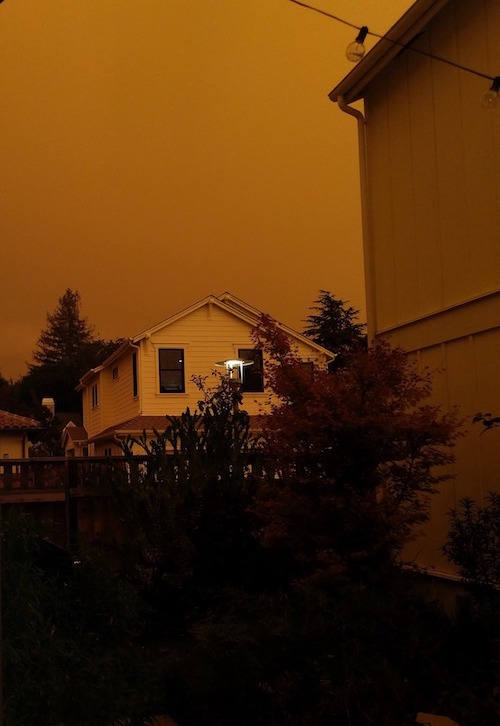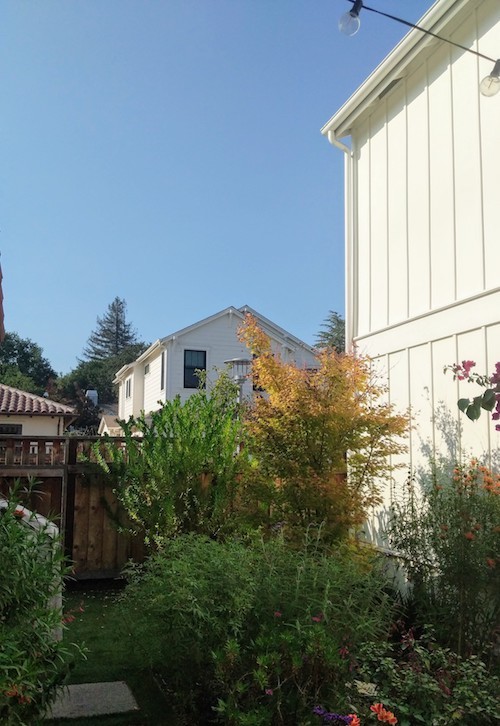Like everyone else in Northern California, I woke up on the morning of September 10 to discover that the sun had apparently stopped shining. One could make out a dim orb hovering in the dark orange sky, but it wasn’t entirely clear whether it was the sun, or the moon, or some grim apparition. As the hours went by, the skies stayed dark and the street lights stayed on.
By this point, forest fires had been raging across the state for three weeks, filling the air with gritty smoke. Venturing outside usually meant upgrading from our standard pandemic-grade cotton masks to the N-95s that we had stashed away two years earlier, following a previous bout of wildfires. During the frantic early days of COVID-19 in March, our little collection of these coveted masks had been a source of guilt, but we were grateful to have them now, modest protection against the choking air. On this strange morning, however, the air was clear. The contrast was jarring, as if we were somehow exchanging oxygen for light.


I sent off an apologetic email to a newly-arrived graduate student. I hoped she wouldn’t be too unsettled by the ominous skies; things would surely return to normal soon.
I paused a bit over the word ‘ominous’, a term that conjured up future uncertainties rather than present crises. If the morning skies appeared to be ablaze, it was because the earth below was burning. The ochre hue was not the stuff of portents and auguries, but rather the result of smoke from faraway fires in Oregon and Washington suspended above the so-called marine layer, the protective cushion of breathable air wafting in from the Pacific.
And yet the skies were ominous. Amidst reassuring reports that our fires, the ones only miles from my house, had at last been contained, the ochre hue offered vivid proof that other fires still raged. Our air might suddenly be clear again, but it was surely only a temporary reprieve. The thick band of smoke hanging just overhead would at some point sink downwards, turning the air from orange back to grey. And even once this too had passed, a thin layer of ash would be a ubiquitous reminder of these dark days. Windowsills, fenceposts, flowers, leaves – all would be covered beneath the grimy relics of infernos near and far.
As a historian of late medieval Europe, I found myself wondering how the men and women whom I study might have reacted. They were no strangers to fire, though it was the burning of cities, rather than forests, that was most often recorded by annalists. Perhaps the smell of smoke was less discomfiting to those who were accustomed to huddling around kitchen fires for warmth. Even the awful darkening of the sun was widely understood as a natural phenomenon – albeit one that often presaged the deaths of kings or other grim tidings. But what of smoke whose origins could not be traced? Or the sudden stillness beneath a feverish sky?
The literate few might have scoured the writings of earlier chroniclers for guidance. For Robert of Torigni, the twelfth-century abbot of Mont Saint-Michel, the ability to learn from such omens was among the chief justifications for the writing of history:
Past prodigies or portents, which betoken famine or pestilence or whatever other scourges of divine vengeance are rightly visited on the sons of men […] are written down so that when similar things happen, sinners who recall what they have done to provoke the Almighty may hasten to the remedies of penitence and confession.1
Yet the records of monkish chroniclers were no match for the terrors of Divine Writ, and many would undoubtedly have taken this terrible convergence of plague, fire, and smoke as the prelude to the end times, as foretold first by the prophet Joel in the Old Testament, and then by Saint Peter himself in the New:
I will show portents in the heavens and on the earth, blood and fire and smoky mist.
The sun shall be turned to darkness, and the moon to blood, before the great and terrible day of the Lord comes.
(Joel 2:30-31; cf. Acts 2:19-20)
Medieval streets would surely have been filled with the sounds of prayers and processions, of frantic atonement for sins and preparation for judgment. In the face of the expected armageddon, the desire for salvation would have thrust aside the routines of daily life.
While our medieval forebears would have been readying themselves for the apocalypse, we are still hoping to prevent it – substituting policies for prayers. Yet they had one notable advantage over us: not even the most radical of medieval heretics would have denied the prospect of the end times, whereas in our own age, many have embraced climate denialism as an article of faith. It remains to be seen whether we will be able to overcome such dangerous dissent – but as California’s wildfires erupt anew, the omens do not seem promising.
Rowan Dorin
October 2020
